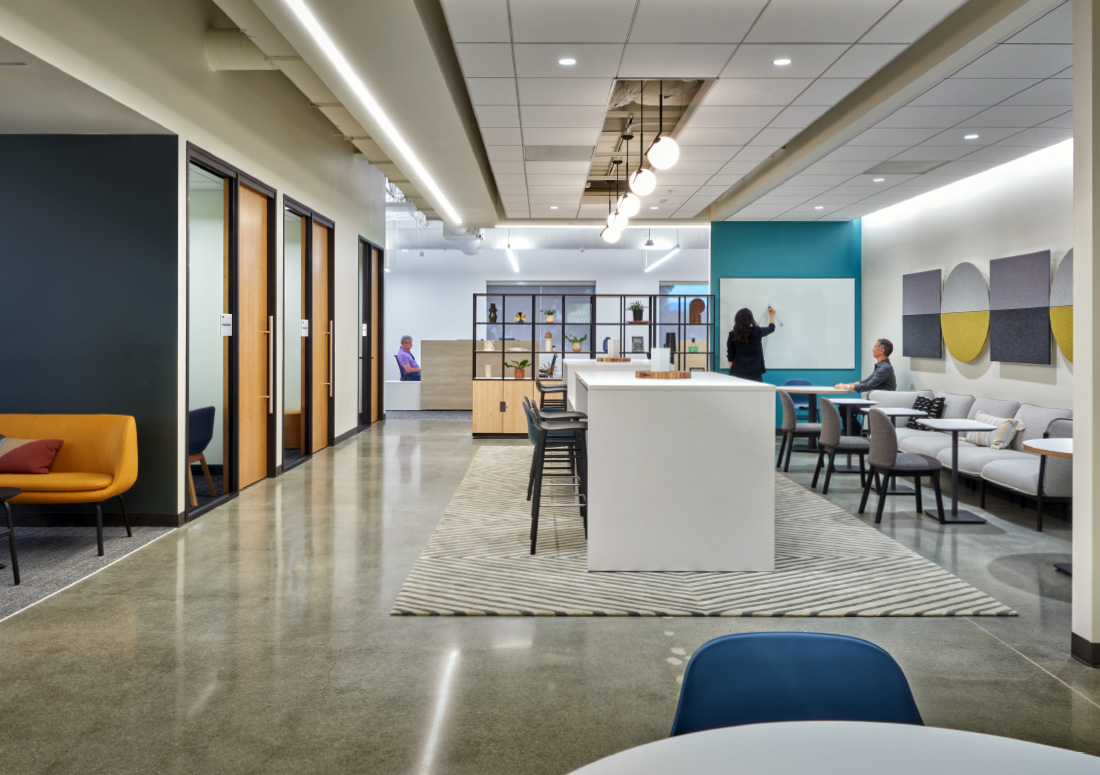Robin Weckesser of a3 Workplace Strategies outlines how to create an effective change management plan as we return to work.

Change management plans aren’t new, but today’s office dynamics are, particularly in a post-pandemic world where the effects of the new normal may linger indefinitely.
To attract and retain top talent, companies continue to embrace pre-pandemic best practices that include workplace solutions designed to offer the latest amenities and technology. Yet today, new health and safety protocols are Job One, with new products and systems needed to ensure the well-being of staff.
Before the pandemic, open offices were the prevailing choice among companies for many reasons, including a reduced footprint with corresponding cost savings, and the belief that openness promotes collaboration and productivity. Today, with office distancing concerns and so many employees still working from home, hybrid environments are more of the norm, and the need to integrate virtual workers is still critical.
No one knows exactly what the new normal will look like, but one thing is clear: change management, once considered an adjunct or isolated undertaking, is now a necessity. Without change management, the risk of damaging company morale and undermining performance is high, and this can harm the bottom line. In fact, it can make or break an enterprise.
While change management takes on many forms, it includes the following elements: a strategic approach, a methodology to optimize resources and engage staff, and digital transformation.

Perform Due Diligence
Employers, always vexed about change, are particularly anxious today as they evaluate options for the new normal workplace. And employees, who may still be immersed in COVID-related matters, need assurances that they can be vital whether in the office or at home.
Addressing these challenges, it is wise to review the latest counsel from workplace experts. A quick summary of two recent articles follows:
- According to Forbes, to provide context for individual projects, several change management models may be useful: Lewin’s Change Management model, the McKinsey 7-S model, Kotter’s theory, and ADKAR. The article accents the need to be flexible and agile. It also speaks to the need for transparency and inclusivity, particularly in these times of turbulence and polarization.
- Another article, references the book Switch, which postulates that the willpower to deal with change is like a muscle that can become fatigued and exhausted; this accentuates the need to support management and staff as they strive to navigate change. The article also explores the obstacles to change along with the opportunities to innovate.

Engage Staff
Change management begins with designing the kind of workplace that takes into account how space can best accommodate function. In other words, show employees that you have considered their task-related needs from the start.
At its core, change management is about involving employees in decision-making and solution development. By giving them a voice, they will feel included and more receptive to change. This will also help ensure the end result reflects their input as the line between work and home becomes more blurred.
Regardless of the size of the project, communication throughout the process will build trust and give employees time to digest and provide constructive feedback. In contrast, asking employees to adopt changes they had no involvement in will likely cause friction.
The way changes are implemented will have a lasting effect on how employees feel about the company, with potentially adverse effects on your corporate culture and brand. Through change management, you have an opportunity to show employees they are valued and their voices are heard—this will boost morale, increase productivity, strengthen the culture, and improve the bottom line.

Customize, Customize, Customize
There is no such thing as a one-size-fits-all change management plan, and an endless pool of options can engage employees in the decision-making process. Traditional methods include sending email and Zoom updates, forming a core project team, interviewing key employees and stakeholders, and creating design mockups. More creative and tech-centric methods include podcasts, video updates, and an Intranet where employees can view plans and provide feedback.
When preparing your change management plan, consider:
- What is the company culture? If there is already a foundation of trust between employees and management, staff will feel more comfortable communicating concerns and be more receptive to change. If there is a divide, employees may see the proposed changes as a “top-down” decision they have no say in, causing resistance. In cases of extreme pushback, more drastic forms of engagement, like an employee summit, may be necessary.
- What are the demographics of your employee base? Most companies have a mix of Gen Z, Millennials, Gen X, and Baby Boomers. With diverse experiences and tech know-how, each generation will likely have different concerns, and this should be reflected in your proposed solutions.
- Tied to the above, how tech-savvy are your employees? The tools you use should reflect the forms of communication your employees are comfortable with. For a responsive, comprehensive plan, a mix of traditional and more modern methods is suggested.
- What is your budget? Be sure to incorporate direct expenses like equipment and indirect expenses such as time your employees may need for interviews or meetings.
Considering these points will help ensure your change management plan is customized for your company’s culture and budget.

Anticipate and Manage Pushback
Even in post-pandemic times when protocols like physical distancing still resonate, the open office still holds some allure. Yet some employees, especially senior managers, may still feel uneasy about switching from private offices to collaborative space. While lack of privacy is a part of their apprehension, they may also fear that giving up their office means compromising their status.
As workplace design becomes less hierarchy-driven, it is important to assure people their role within the company will be recognized. Additionally, many don’t realize that open offices are often a hybrid of shared and private space that meets a wide range of needs. So, be prepared for initial pushback, but with proper communication, education, and patience, you can change employees’ perspectives.
Numerous companies experience similar pushback during office transformation, and each has to factor in budget and cultural considerations to engage employees. From workplace design retreats with key staff to company-wide lunch meetings, effective ways to shift attitudes include visual and hands-on approaches:
- Workshops can help staff look at how they work today and how they could work in alternative settings. Employees might be asked to visualize and create their perfect office. Working in teams or alone, this will encourage employees to think differently about their function and will provide critical feedback.
- Take employees on a tour of alternative office environments within the company or with a different company. Give them time to chat with employees who can help ease their fears and address their concerns about privacy and distractions.
- Present proposed changes to employees through digital models, blueprints, or PowerPoint presentations. Then, candidly review the designs and address needs and concerns. Ask them what they would change and why, if they think anything is missing or unclear.

Transform Your Workplace
As technology and workplace demographics continue to evolve, the office will continue its transformation to accelerate the production cycle, attract and retain talent, and optimize performance. No longer tethered to our desks by a wire, we will become an even more mobile workforce with employees enjoying more of a “live-work-play” lifestyle.
So, welcome to the future, where project management and change management are no longer separate entities. They must work in synch from start-to-finish to ensure successful projection execution. While some companies have a project management discipline in-house, companies typically outsource this function to specialists. To optimize your success in today’s high-stakes environment, plan ahead and consider an experienced project management firm that provides a change management plan as a part of its services.
To be sure, the office will never be the same, and the new normal will continue to evolve. Are you prepared? No matter your industry or location, with patience, due diligence, and a customized change management plan, you can make the workplace of the future work for you today and tomorrow.

